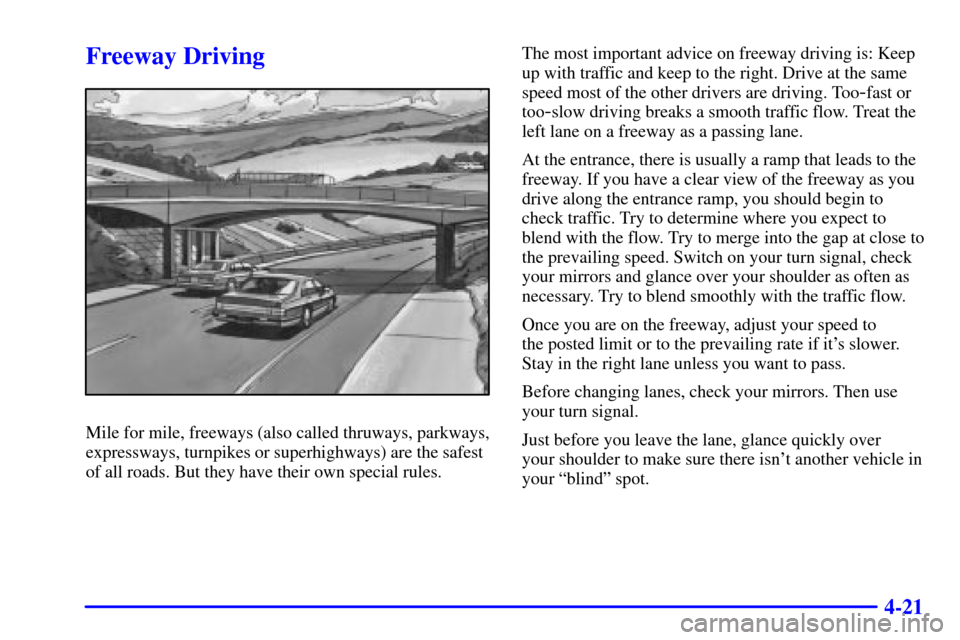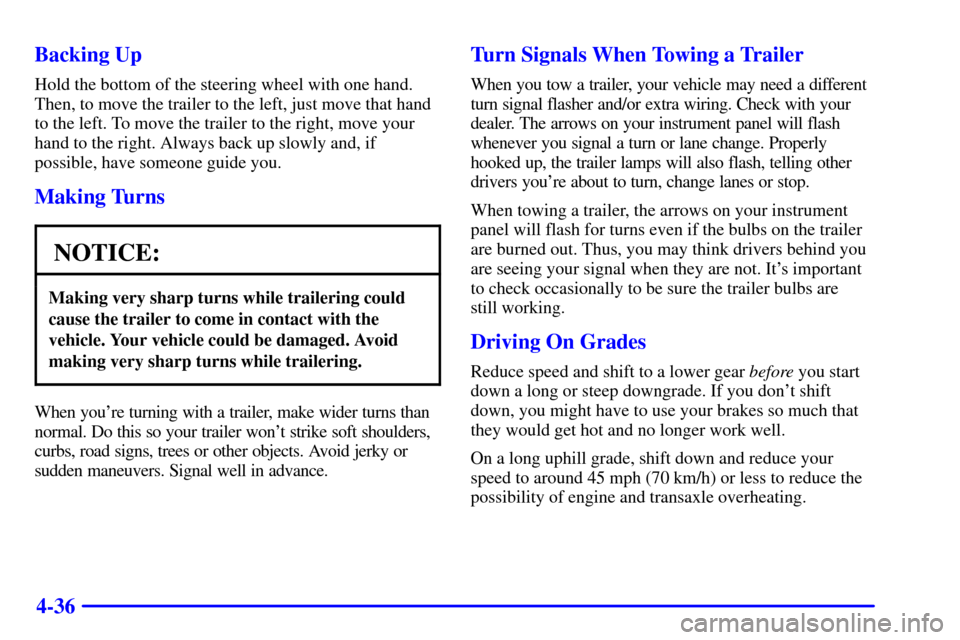Page 207 of 335
4-20
City DrivingOne of the biggest problems with city streets is the
amount of traffic on them. You'll want to watch out for
what the other drivers are doing and pay attention to
traffic signals.
Here are ways to increase your safety in city driving:
�Know the best way to get to where you are going. Get
a city map and plan your trip into an unknown part of
the city just as you would for a cross
-country trip.
�Try to use the freeways that rim and crisscross most
large cities. You'll save time and energy. See the
next part, ªFreeway Driving.º
�Treat a green light as a warning signal. A traffic light is
there because the corner is busy enough to need it.
When a light turns green, and just before you start to
move, check both ways for vehicles that have not
cleared the intersection or may be running the red light.
Page 208 of 335

4-21
Freeway Driving
Mile for mile, freeways (also called thruways, parkways,
expressways, turnpikes or superhighways) are the safest
of all roads. But they have their own special rules.The most important advice on freeway driving is: Keep
up with traffic and keep to the right. Drive at the same
speed most of the other drivers are driving. Too
-fast or
too
-slow driving breaks a smooth traffic flow. Treat the
left lane on a freeway as a passing lane.
At the entrance, there is usually a ramp that leads to the
freeway. If you have a clear view of the freeway as you
drive along the entrance ramp, you should begin to
check traffic. Try to determine where you expect to
blend with the flow. Try to merge into the gap at close to
the prevailing speed. Switch on your turn signal, check
your mirrors and glance over your shoulder as often as
necessary. Try to blend smoothly with the traffic flow.
Once you are on the freeway, adjust your speed to
the posted limit or to the prevailing rate if it's slower.
Stay in the right lane unless you want to pass.
Before changing lanes, check your mirrors. Then use
your turn signal.
Just before you leave the lane, glance quickly over
your shoulder to make sure there isn't another vehicle in
your ªblindº spot.
Page 223 of 335

4-36 Backing Up
Hold the bottom of the steering wheel with one hand.
Then, to move the trailer to the left, just move that hand
to the left. To move the trailer to the right, move your
hand to the right. Always back up slowly and, if
possible, have someone guide you.
Making Turns
NOTICE:
Making very sharp turns while trailering could
cause the trailer to come in contact with the
vehicle. Your vehicle could be damaged. Avoid
making very sharp turns while trailering.
When you're turning with a trailer, make wider turns than
normal. Do this so your trailer won't strike soft shoulders,
curbs, road signs, trees or other objects. Avoid jerky or
sudden maneuvers. Signal well in advance.
Turn Signals When Towing a Trailer
When you tow a trailer, your vehicle may need a different
turn signal flasher and/or extra wiring. Check with your
dealer. The arrows on your instrument panel will flash
whenever you signal a turn or lane change. Properly
hooked up, the trailer lamps will also flash, telling other
drivers you're about to turn, change lanes or stop.
When towing a trailer, the arrows on your instrument
panel will flash for turns even if the bulbs on the trailer
are burned out. Thus, you may think drivers behind you
are seeing your signal when they are not. It's important
to check occasionally to be sure the trailer bulbs are
still working.
Driving On Grades
Reduce speed and shift to a lower gear before you start
down a long or steep downgrade. If you don't shift
down, you might have to use your brakes so much that
they would get hot and no longer work well.
On a long uphill grade, shift down and reduce your
speed to around 45 mph (70 km/h) or less to reduce the
possibility of engine and transaxle overheating.
Page 226 of 335
5-2
Hazard Warning Flashers
Your hazard warning flashers let you warn others. They
also let police know you have a problem. Your front and
rear turn signal lamps will flash on and off.
Press the button in to make your front and rear turn
signal lamps flash on and off.
This light on the instrument
panel will flash, indicating
that the hazard warning
flashers are on.
The hazard warning flashers will work once the button
is pressed in regardless of the ignition key position.
Page 227 of 335
5-3
Pull out on the collar to turn the flashers off. When the
hazard warning flashers are on, the turn signals won't
work since they are already flashing.
Other Warning Devices
If you carry reflective triangles, you can set one up at
the side of the road about 300 feet (100 m) behind
your vehicle.
Jump Starting
If your battery has run down, you may want to use
another vehicle and some jumper cables to start your
vehicle. Please follow the steps below to do it safely.
CAUTION:
Batteries can hurt you. They can be
dangerous because:
�They contain acid that can burn you.
�They contain gas that can explode or ignite.
�They contain enough electricity to
burn you.
If you don't follow these steps exactly, some or all
of these things can hurt you.
Page 290 of 335
6-36 Front Turn Signal Lamps
1. The turn signal lamps are located on the outboard
side of the headlamps. To access them, turn the lock
tabs on the headlamp cover in the direction of the
arrows and then lift off the cover. (See Steps 1 and
2 under ªHeadlampsº listed previously.)
2. Turn the housing socket counterclockwise to unlock
the socket from the lamp housing.
3. Remove the turn signal lamp housing socket and
replace the bulb.
Reverse Steps 1 through 3 to reassemble.
Page 292 of 335
6-38 Rear Turn Signal Lamps and Taillamps
1. Open the trunk to gain access to the lamp housing.
2. Remove the convenience net and pull the trim away
to access the wing nuts.
3. Remove the two wing nuts.
4. Gently remove the lamp housing.
5. Press the bulb housing lever and turn the housing
counterclockwise to remove it. To remove the bulb,
push and turn it counterclockwise.
Page 321 of 335

6-67
Replacement Bulbs
Application Number
Headlamps Composite
Inner High Beam 9005. . . . . . . . . . . . . . . . . . . . . . .
Outer Low Beam 9006. . . . . . . . . . . . . . . . . . . . . . .
Front Turn Signal 3157 NA. . . . . . . . . . . . . . . . . . . . .
Center High
-Mounted Stoplamp (CHMSL) 1156. . .
Rear Turn Signal and Taillamp 2057. . . . . . . . . . . . .
Capacities and Specifications
The following approximate capacities are given in
English and metric conversions. Please refer to
ªRecommended Fluids and Lubricantsº in the
Maintenance Schedule booklet for more information.
Engine Specifications
Displacement 279 cubic inches (4 565 cc). . . . . . . . .
Type 4.6 L DOHC V8. . . . . . . . . . . . . . . . . . . . . . . . .
VIN Engine Code
Eldorado Y. . . . . . . . . . . . . . . . . . . . . . . . . . . . . . . .
ETC 9. . . . . . . . . . . . . . . . . . . . . . . . . . . . . . . . . . . .
Horsepower
Eldorado 275 (bhp) @ 5600 rpm. . . . . . . . . . . . . . .
205 (kW) @ 5600 rpm
ETC 300 (bhp) @ 6000 rpm. . . . . . . . . . . . . . . . . . .
224 (kW) @ 6000 rpm
Torque
Eldorado 300 (lb
-ft) @ 4000 rpm . . . . . . . . . . . . . .
407 (N´m) @ 4000 rpm
ETC 295 (lb
-ft) @ 4400 rpm . . . . . . . . . . . . . . . . . .
400 (N´m) @ 4400 rpm
Firing Order 1
-2-7-3-4-5-6-8 . . . . . . . . . . . . . . . . . . .
Thermostat Starts To Open 177
-184�F (81-85�C) . .
Page:
< prev 1-8 9-16 17-24